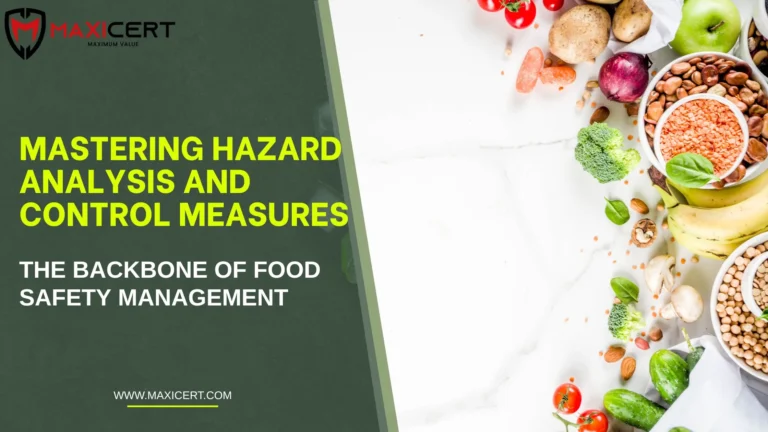Mastering Hazard Analysis and Control Measures: The Backbone of Food Safety Managemen

Introduction
In the food industry, ensuring the safety of products is a top priority. A robust Food Safety Management System (FSMS)—aligned with ISO 22000—relies heavily on effective hazard analysis and control measures to identify, assess, and mitigate risks that could compromise food safety. From raw material handling to final product distribution, every step in the food chain must be scrutinized to prevent contamination and protect consumer health.
This blog explores the critical role of hazard analysis, the selection of control measures, and the implementation of operational prerequisite programs (PRPs) and HACCP plans. Whether you’re a food producer, processor, or distributor, understanding these principles will help you build a system that ensures ISO certification, enhances consumer trust, and safeguards public health.
For expert guidance in building or upgrading your FSMS, Maxicert—a worldwide ISO consultant and certification expert—is here to support you with global best practices and tailored solutions.
Food Safety Management System
2.4.1 General
The food safety team shall conduct a hazard analysis to which hazards need to be controlled, the degree of control required to ensure food safety, and which combination of control measures is required.
Request A Free Quote
2.4.2 Hazard identification and determination of acceptable levels
2.4.2.1 All food safety hazards that are reasonably expected to occur in relation to the type of product, type of process and actual processing facilities shall be identified and recorded. The identification shall be based on
- The preliminary information and data were collected.
- Experience.
- External information, including, to the extent possible, epidemiological and other historical data.
- Information from the food chain on food safety hazards that may be of relevance for the safety of the end products, intermediate products and the food at consumption.
The step(s) (from raw materials, processing and distribution) at which each food safety hazard may be introduced shall be indicated.
2.4.2.2 When identifying the hazards, consideration shall be given to
- The steps preceding and following the specified operation.
- The process equipment, utilities/services and surroundings.
- The preceding and following links in the food chain.
2.4.2.3 For each of the food safety hazards identified, the acceptable level of the food safety hazard the end product shall be determined whenever possible. The determined level shall take into account established statutory and regulatory requirements, customer food safety requirements, the intended use by the customer and other relevant data. The justification for, and the result of, the termination shall be recorded.
2.4.3 Hazard assessment
hazard assessment shall be conducted to determine, for each food safety hazard identified, whether its elimination or reduction to acceptable levels is essential to the production of a food, and whether its control is needed to enable the defined acceptable levels to be met. Each food safety hazard shall be evaluated according to the possible severity of adverse health effects and the likelihood of their occurrence. The methodology used shall be described, and the results of the food safety hazard assessment shall be recorded.
2.4.4 Selection and assessment of control measures
Based on the hazard assessment, an appropriate combination of control measures shall be selected which is capable of preventing, eliminating or reducing this food safety hazards to defined acceptable levels. In this selection, each of the control measures as described shall be reviewed with respect to its effectiveness against the identified food safety hazards.
The control measures selected shall be categorized as to whether they need to be managed through operational PRP(s) or by the HACCP plan. The selection and categorization shall be carried out using a logical approach that includes assessments with regard to the following:
- Its effect on identified food safety hazards relative to the strictness applied.
- Its feasibility for monitoring (e.g. ability to be monitored in a timely manner to enable immediate corrections).
- Its place within the system relative to other control measures.
- The likelihood of failure in the functioning of a control measure or significant processing variability.
- The severity of the consequence(s) in the case of failure in its functioning.
- Whether the control measure is specifically established and applied to eliminate or significantly reduce the level of hazard(s).
- Synergistic effects (i.e. interaction that occurs between two or more measures resulting in their combined effect being higher than the sum of their individual effects).
Control measures categorized as belonging to the HACCP plan shall be implemented. Other control measures shall be implemented as operational PRPs. The methodology and parameters used for this categorization shall be described in documents, and the results of the assessment shall be recorded.
2.5 Establishing the operational prerequisite programmes (PRPs)
The operational PRPs shall be documented and shall include the following for each programme:
- Food safety hazard(s) to be controlled by the programme.
- Control measures.
- Procedures that demonstrate that the operational PRPs are implemented.
- Corrections and corrective actions to be taken if monitoring shows that the operational PRP are not in control.
- Responsibilities and authorities.
- f) Records of monitoring.
Conclusion
Effective hazard analysis is the cornerstone of a robust Food Safety Management System (FSMS). By identifying, assessing, and controlling potential food safety hazards, organizations can ensure their products meet both regulatory requirements and consumer expectations. Implementing appropriate control measures, whether through operational prerequisite programs (PRPs) or a HACCP plan, minimizes risk and enhances overall food safety.
The operational PRPs shall be documented and shall include the following for each program:
Food safety hazard(s) to be controlled by the program.
Control measures.
Procedures that demonstrate that the operational PRPs are implemented.
Corrections and corrective actions to be taken if monitoring shows the PRPs are not in control.
Responsibilities and authorities.
Records of monitoring.
A well-structured approach to hazard assessment and control not only protects public health but also strengthens brand reputation and ensures ongoing ISO 22000 compliance.
Need expert support? Maxicert is your trusted global ISO consultant for ISO certification in the food sector. We help organizations worldwide implement reliable food safety systems that meet international standards.
Learn more at Maxicert.com – your partner in food safety excellence.
If you’re ready to strengthen your food safety practices and achieve ISO certification, Maxicert is here to help. As a best consultant for ISO standards, we provide expert guidance and end-to-end support to help your organization implement and maintain a strong FSMS. Visit Maxicert to start your certification journey with confidence.

Get In Touch

Get In Touch

Get In Touch
Need A Free Estimate?
Get a free consultation and Checklist to get certified for ISO , HALAL, CE Mark Certification.
FAQ
What is the purpose of hazard analysis in food safety management?
Hazard analysis helps identify, assess, and control potential food safety hazards that could compromise product safety. It ensures that necessary control measures are in place to prevent contamination and protect consumer health.
. What are the key steps in conducting a hazard analysis?
The key steps include hazard identification, determining acceptable levels, assessing the severity and likelihood of hazards, and selecting appropriate control measures based on risk evaluation.
. What is the difference between HACCP and operational PRPs?
HACCP (Hazard Analysis and Critical Control Points) focuses on identifying and controlling significant hazards at critical points in the food production process. Operational PRPs (Prerequisite Programs) manage basic conditions necessary for food safety, such as sanitation, hygiene, and pest control.



